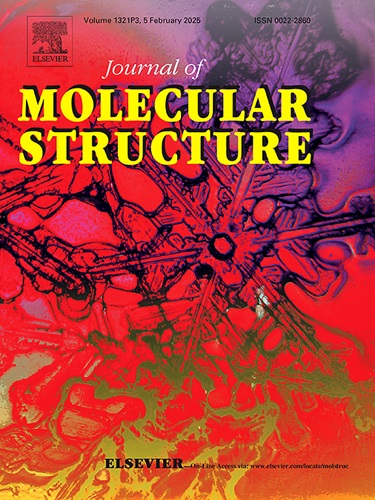多组分反应合成的新型取代螺吡咯烷杂环对枯草芽孢杆菌和铜绿假单胞菌的抑菌活性
IF 4
2区 化学
Q2 CHEMISTRY, PHYSICAL
引用次数: 0
摘要
细菌对抗菌剂的耐药性日益增强,因此需要新的策略来对抗细菌感染,特别是那些与生物膜形成有关的策略。生物膜增强了细菌对恶劣环境、免疫反应和抗菌治疗的抵抗力。生物膜影响细菌发病机制的能力强调了对具有抗生物膜活性的新型抗菌剂的迫切需要。本研究旨在合成具有破坏生物膜形成生物学意义的经济高效、结构多样的化合物。在这里,我们报道了一个简单的顺序反应,一锅,四组分合成螺吡咯烷杂环与1,3-偶极环加成的亚甲基酰亚胺。在温和的反应条件下,多组分反应(MCR)具有较高的产率和区域选择性。这些新化合物的初步筛选包括生物膜分析,评估生物膜的发育过程,为化合物的生物学潜力提供见解。随后的体外实验用最低抑菌浓度(MIC)法评估了它们对枯草芽孢杆菌和铜绿假单胞菌的抑菌潜力。细胞培养试验评估了这些化合物在MDA-MB-231细胞系中的毒性。所有这些研究都表明了这些分子作为枯草芽孢杆菌和铜绿假单胞菌的抗菌剂的潜力。本文章由计算机程序翻译,如有差异,请以英文原文为准。

Antimicrobial activities of novel substituted spiropyrrolidine based heterocycles synthesized by multicomponent reaction against Bacillus subtilis and Pseudomonas aeruginosa
The growing resistance of bacteria to antimicrobial agents has intensified the need for novel strategies to combat bacterial infections, particularly those associated with biofilm formation. Biofilms enhance bacterial resilience against hostile environments, immune responses, and antimicrobial treatments. The ability of biofilms to influence bacterial pathogenesis underscores the critical need for new antibacterial agents with anti-biofilm activity. This research aims to synthesize cost-effective, structurally diverse, chemical compounds with the biological significance of disrupting biofilm formation. Here, we report a facile sequential reaction for one-pot, four-component synthesis of spiropyrrolidine heterocycles with 1,3-dipolar cycloaddition of azomethine ylide. The multicomponent reaction (MCR) provides high yield and regioselectivity of the desired product, under mild reaction conditions. Preliminary screening for these novel compounds involves biofilm assays, which assess the developmental processes of biofilms, providing insights into the compounds' biological potential. Subsequent in vitro experiments assessed their antibacterial potential against B. subtilis and P. aeruginosa using the minimum inhibitory concentration (MIC) assay. A cell culture assay evaluated toxicity of these compounds in MDA-MB-231 cell lines. All these investigations cumulatively highlight the potential of these molecules as antibacterial agents for B. subtilis and P. aeruginosa.
求助全文
通过发布文献求助,成功后即可免费获取论文全文。
去求助
来源期刊

Journal of Molecular Structure
化学-物理化学
CiteScore
7.10
自引率
15.80%
发文量
2384
审稿时长
45 days
期刊介绍:
The Journal of Molecular Structure is dedicated to the publication of full-length articles and review papers, providing important new structural information on all types of chemical species including:
• Stable and unstable molecules in all types of environments (vapour, molecular beam, liquid, solution, liquid crystal, solid state, matrix-isolated, surface-absorbed etc.)
• Chemical intermediates
• Molecules in excited states
• Biological molecules
• Polymers.
The methods used may include any combination of spectroscopic and non-spectroscopic techniques, for example:
• Infrared spectroscopy (mid, far, near)
• Raman spectroscopy and non-linear Raman methods (CARS, etc.)
• Electronic absorption spectroscopy
• Optical rotatory dispersion and circular dichroism
• Fluorescence and phosphorescence techniques
• Electron spectroscopies (PES, XPS), EXAFS, etc.
• Microwave spectroscopy
• Electron diffraction
• NMR and ESR spectroscopies
• Mössbauer spectroscopy
• X-ray crystallography
• Charge Density Analyses
• Computational Studies (supplementing experimental methods)
We encourage publications combining theoretical and experimental approaches. The structural insights gained by the studies should be correlated with the properties, activity and/ or reactivity of the molecule under investigation and the relevance of this molecule and its implications should be discussed.
 求助内容:
求助内容: 应助结果提醒方式:
应助结果提醒方式:


